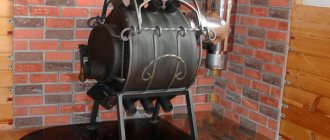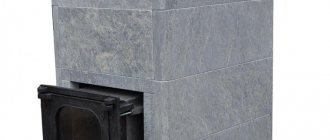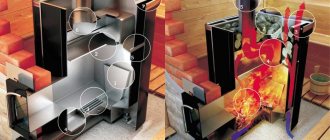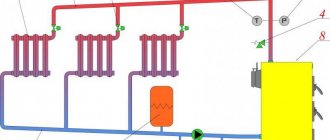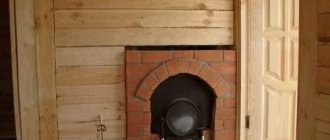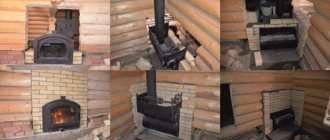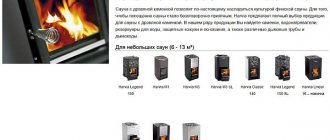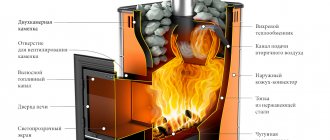Heating a house with a wood stove is quite possible. Especially if it is a modern model with a powerful heat input. However, this applies to small houses with one or two rooms. For heating a large area and more rooms, a wood stove with a water circuit and a heat exchanger is better suited. This combination will allow you to evenly distribute heat throughout the rooms and create truly comfortable conditions.
A sauna stove with a heat exchanger: what is it?
The idea of using as much heat as possible from a stove is not new. A good application is to use it to heat the coolant.
For your information! The principle of any heat exchanger is to ensure maximum contact of an insulated liquid carrier with a heated surface to increase heat transfer between them.
Many designs have been invented to implement this. Let's look at them according to the purpose of the heated liquid.
Electric heating
There are several options: you can install an electric boiler, since electricity is available almost everywhere. If we talk from a safety point of view, an electric boiler for heating a bathhouse is the safest option (subject to compliance with the rules and regulations). But the downside is that electricity costs a lot today, so you will have to pay large electricity bills. Another difficulty is that you will have to provide a separate input to connect the boiler, and often not 220V, but 380V is required, and these are completely different requirements and tariffs.
Electric boilers for water heating baths
If you use modern models of electric water heating units, then the bills may not be very large: they are controlled automatically, which maintains the set temperature in the room. You can set the temperature to +50C while you are not visiting the bathhouse. And the system will not freeze, and the bill will be small (provided that your building is well insulated). Moreover, to heat the bath, you can use stepped heating element boilers, induction and electrode (ion). They are not ideal, but according to experience, they are economical: bills come in 20-30% less.
Bath heating with convectors
If possible, it is most convenient to use electric convectors. Such a heating system in a bathhouse, of course, will be expensive. The equipment is not cheap, and electricity bills will also be hefty. But what is good about modern convectors: it is possible to set a certain thermal regime, which is maintained automatically. Many bathhouse owners do the following: while using the bathhouse, they heat the heater, and then set the anti-defrosting mode of the convector, which maintains the room temperature within +1 - +30C. Thus, the bathhouse premises do not freeze or become damp, and heating the bathhouse in winter will not cost a lot of money.
Heating in the bathhouse using convectors. Simple, but expensive and not always reliable
Electric heated floors
A very comfortable, but expensive type of heating. This applies to both the arrangement and the bills that will arrive. But if the bathhouse is insulated correctly and carefully, then maintaining the minimum temperature may not be so burdensome.
One more point: the system is installed at the stage of construction or major renovation, which is also not very convenient. Modern electric heated floors are no longer just cords that were laid out on the surface, and if damaged, part of the floor turned out to be unheated. There are roll materials with parallel thermal tracks. If one or more fail, the performance of the others remains unchanged, and the floor is still as warm.
Warm floors in the bathhouse can be made electric or water
Application area
Wasted heat can be used for two purposes:
- for heating water to be used for washing;
- for heating rooms.
Of course, such goals can be combined if the stove is powerful enough. After all, we will, in fact, be taking away part of the heat that would otherwise be used to heat the steam room (or atmosphere)).
Scheme of heating water in a remote tank with a samovar-type heat exchanger (video with explanation, see below)
Bath stove with water heat exchanger
This is the first time. We are talking exclusively about water (no antifreeze), the consumption of which depends on the number of people who can wash in the bathhouse at the same time and other factors. In any case, you can’t do without a spacious tank. And here again you have options for where to place it:
- some place the tank directly on the stove , which must have an appropriate design for this. Water is supplied to the washing room from the steam room;
- others use a heat exchanger , and the tank itself is placed in an adjacent room, from where it is connected by two pipes to the heat exchanger.
Both designs of stoves with a tank have a right to exist, and the choice is yours.
Bath stove with heat exchanger for heating
If instead of a tank you connect a heat exchanger with a radiator, you get an autonomous heating system .
Here again you have two options):
- or create a design that is based on phenomena such as convection and gravity;
- or force the coolant to forcefully move in the system - for this you will need a pump, and therefore electricity (! A separate section is devoted to electric stoves).
If the bathhouse is small, then there is no need to bother with even the simplest system, because usually the stove is enough to heat adjacent rooms . But what matters here is what kind of winters you have. It happens that a small bathhouse needs additional heating.
It was already mentioned above that it is possible to combine heating of water for washing and heating. In fact, you can make two parallel systems, and use antifreeze rather than water for heating. For this purpose, one heat exchanger will need to be placed inside the stove, and the second - on the chimney. From the point of view of increasing the efficiency of the furnace, this option is simply excellent.
On a note! When creating a heating system, do not forget about the expansion tank , which will absorb excess coolant.
Heating with water and liquid fuel
Water heating is becoming more and more popular today. This is facilitated by the large selection of equipment that can be used. It should be remembered that this type of heating in a bathhouse should be arranged in such a way that during the warm season it can be turned off, leaving the heat exchanger to work only to heat the water. That is, you need to purchase a boiler with two circuits.
It is carried out using three types of fuel:
Gaza. To organize heating with gas, you must be connected to a common gas supply system. You will also need special equipment through which the fuel will flow. On the territory of our country there are a large number of settlements that are still not provided with gas. An alternative type of fuel – liquefied or bottled gas – has a higher fire hazard. Electricity
In order for electric heating to provide a comfortable room temperature, it is important to accurately select the power of the equipment. Due to the complexity of these calculations, it is not recommended to purchase and install an electric boiler yourself
Unlike gas heating, using electricity does not require the installation of a chimney. The disadvantage is the high cost of electric boilers, as well as the complexity of the technical process. Firewood. The wood-burning system allows you to warm up the room relatively quickly. In general, heating a steam room in a private house using wood-burning equipment is traditional. But many people do not like the complexity of the process of procuring fuel and lighting the stove.
Types of devices
The furnace provides several options for placing heat exchangers:
A coil or water circuit is a steel structure that can be located both inside the furnace and outside , for example, between the furnace wall and the casing. Its use is not limited to metal stoves - water circuits can also be built into brick ones.
The shape and size can vary significantly from a simple C-shaped, once bent tube with fittings , which is located inside the firebox, to a water jacket around the entire body.
IMPORTANT! The correct location of the metal pipe inside the furnace is always such that the open flame does not touch it in any area. It should be remembered that even stainless steel is subject to oxidation in a flame.
A large tank that touches the walls of the furnace with a wall or bottom (or both) can also be considered a type of heat exchanger.
For your information! By taking heat away from the stove body to heat water, you reduce the operating power of the stove.
But in the design of all furnaces there is an element that in most cases (but not in all!) becomes the cause of significant heat loss - this is the chimney, where very hot furnace gases are sent (if the furnace does not have a smoke circulation system).
The second type of heat exchangers tries to correct this shortcoming. For this purpose, either a small flow-through tank of 5-10 liters , communicating with a large tank outside the steam room, or a full-fledged tank, from where hot water is supplied to the washing room. (In the latter case, there are more difficulties with fastening.)
Photo: samovar-type heat exchanger
Photo: heat exchanger tank on a pipe
By the way! The external tank, among other things, also serves as a heater for the room in which it is installed (dressing room or washing room).
Gas heating
The implementation of such a heating system has several options.
- Firstly, as I wrote above, it is possible to install a “classic” heater, in which a gas burner will be used instead of firewood.
- Secondly, you can use a standard gas boiler (the same as in residential buildings). But in this case, you will have to take care of the equipment of heating systems (installation of heating radiators, laying pipes, connecting a gas-carrying pipe to the bathhouse or a cylinder connection system).
- Thirdly, there is the possibility of installing heating from the house. In essence, this is the same option as the previous one, but with its own characteristics and disadvantages. A separate heating main is laid from the boiler used to heat the house to the bathhouse. This option is very convenient if your steam room is adjacent to the house or is very close to it.
If the distance to the bathhouse is relatively large, then in order to use this system in winter it is necessary to bury the heating main below the freezing level of the soil and insulate it well. This will prevent the possibility of defrosting and help reduce heat loss.
True, the undoubted advantage of this option is the complete elimination of the problem of maintaining a constant positive temperature in the bathhouse. In addition, you can do all the necessary work (if you have a certain skill) with your own hands.
How it works
It is easy to guess that in the case of a flow-through water circuit or a tank mounted on a chimney, it is necessary to ensure constant circulation of liquid between it and the storage tank outside the steam room.
This can be done either through the natural laws that water obeys (and such a system is considered open), or with the help of a pump that provides forced circulation.
IMPORTANT! Natural circulation based on gravity and convection is preferable. Connecting pipes must have a diameter of at least one inch and a length of no more than 3 meters.
Look at the diagram above, which clearly shows how the pipes should be positioned so that the water rises and falls freely. Below is a video explaining the diagram.
DANGEROUS! Before lighting the stove, make sure there is water in the system!
Video
Watch a short video that explains the above diagram of a stove for a bath with a heat exchanger for water (this principle can also be used for heating) and shows an example of its budget implementation:
Watch the video from our channel: Bath stove with heat exchanger and remote water tank (diagram and example)
For the bath
For a sauna, the main emphasis is on the heating speed. The stove is used sporadically and the room needs to be heated quickly. Water is needed to heat the dressing room using classic radiators or warm baseboards and, possibly, for a heated floor system.
You can use any option with the exception of the boiler, which, by definition, takes a long time to gain temperature. Taking into account the active combustion of wood in a heater stove, even a heat exchanger for the chimney is relevant. The temperature of the gases is more than enough to maintain thrust and heat the coolant.
In this case, it is not advisable to organize heating with natural circulation; when the steam room is ready in the bathhouse, the heating will only begin to warm up. Options with extremely high heat transfer are not suitable.
It is easier and more efficient to install a pump and pump the coolant through radiators and underfloor heating pipes, to arrange the heating to use the coolant temperature in the range of up to 60°C and not higher.
Popular furnaces with heat exchangers
Cast iron stoves are deservedly popular among lovers of Russian baths, but how are they combined with heat exchangers? As it turns out, they combine perfectly.
Cast iron stove
To get started, we recommend visiting the website of the Petrozavodsk stove manufacturer Karelia. Among the products offered to visitors are components, among which there is a disk-shaped heat exchanger, apparently attached to one of the walls of the furnace. Thus, you can purchase both a stove and an exchanger at once. As an option, they also sell mounted tanks for the chimney.
Cast iron stove with heat exchanger for a bath. Photo source
Vesuvius stove
Vesuvius stove with heat exchanger for a bath
The stove manufacturer Vesuvius also provides the opportunity to simultaneously purchase a stove (and in its catalog you will find both steel and cast iron stoves) and a heat exchanger . The buyer is given a choice of three models - two “samovars” for the chimney, differing in capacity, and one rectangular heat exchanger, which takes heat from the stove wall.
photo of heat exchangers on the Vesuvius website
Stoves for baths "Termofor"
There is a message on the Termofor website that the manufacturer took into account customer preferences and produces the most popular models - Tunguska 16 and Tunguska 24 - with already installed heat exchangers , which require an external location of the storage tank. The material of the exchangers is high-quality food grade stainless steel, 2 mm thick . Depending on the buyer’s choice, the placement can be varied by installing it either on the right or on the left wall of the stove.
Useful video
Termofor sauna stoves with a heat exchanger may be built well, but there are negative reviews. Watch the video and see what it looks like:
DIY making
Despite the availability of different options for sale, you can try your hand at making a heat exchanger yourself. It's not that difficult if you have welding experience. In any case, it’s easier than making a stove from scratch.
But before you get started, you need to do a little calculation.
Calculation of heat exchanger power and area
It was already mentioned above that heat exchangers connected to the body take away part of the furnace power. Therefore, the first rule will be the following:
IMPORTANT! The heat exchanger power should not be more than 1/10 of the furnace power.
The second rule is related to the length of the pipes: if the system is gravity-fed, then you should not extend the pipes further than three meters. The pump in the system eliminates such restrictions. But the pump is installed more often when the coolant is used to heat rooms. However, if the storage tank is not located too high, you can only wash with a hose. If this is inconvenient, then you need to either take the tank into the attic and insulate it, or install the same pump.
The third rule concerns the volume of the heat exchanger (if it is a small flow-through tank and not a coil). The water in it should heat up within a couple of hours. If it’s longer, then the volume is too big. If it is faster, then it is better only at first glance - the water should not boil, this will cause scale, steam, testing the expansion tank, and other problems.
Now, actually, the calculation itself:
The power of the heat exchanger depends on its area: 9 kW for each square meter of exchanger . The area is quite simple to calculate: if it is a coil, then multiply the circumference (3.14 * diameter) by the length of the pipe. If this is a “samovar” heat exchanger, then take the diameter of the inner pipe, multiply it by the number Pi, and multiply it again by the height of the “samovar”.
Power = resulting area in sq. meters * 9 kW.
If the exchanger hangs on the chimney, you can ignore the rule of deducting its power from the power of the stove. Only if he is on or in her body.
You can calculate the power required to heat a room using the same principle as for a steam room, that is, based on the volume of the room. In the steam room, a kilowatt per cubic meter is taken, but the adjacent ones do not need high temperature, so focus on half the value.
Knowing how many kilowatts are needed to heat a washing room, you get the area of the heat exchanger, and from it the length of the pipe for the “samovar” or coil.
Let's consider a couple of options for self-manufacturing heat exchangers.
Let's assume that you decide to increase the efficiency of the stove by installing a heat exchanger on the chimney.
- The thickness of the steel required for this is 2.5 mm.
- In addition to the sheet material, you will need two pipes with different diameters.
- The smaller one should be adjacent to the chimney pipe, the larger one should be 5-10 cm wider than the first one.
- Two circles are cut out of sheet metal to fit the diameter of the larger pipe, then a hole is cut in the center to fit the diameter of the smaller one and everything is carefully welded.
- You also need to make holes for the pipes through which water will come and go.
- The pipes are threaded and must match the diameter of the connecting pipes.
ADVICE! After checking the tightness of the seams, installation on the chimney and routing of pipes, it is recommended to insulate the heat exchanger using mineral wool and foil - this will dramatically increase the rate of water heating.
Another option for a heat exchanger for a chimney is a coil made of a copper tube with a diameter of 10 mm, which is made to tightly wrap around the chimney pipe. 1.5-2 meters of pipe is enough. The ends of the coil are inserted into the nuts, flared under the fittings, and then the fittings are screwed to the nuts.
Note! The copper tube must be flared exactly under the cone of the fitting so that they eventually fit tightly against each other. Be careful because this is where leaks can occur in the future if you flare at an uneven thickness.
Here are a couple of videos on the topic:
Video
How to bend a copper tube yourself with a pipe bender.
Without pipe bender.
Features of the selection, installation and operation of fireplace stoves
In order for home heating to be efficient and safe, when purchasing, installing and using industrial stoves with a fireplace effect, you need to take into account some nuances:
- power selection;
- housing and heat exchanger material;
- safe installation conditions;
- rules for connecting to the heating system;
- requirements for the installation of a chimney;
- selection of firewood and other types of fuel;
- proper firebox, cleaning and maintenance with your own hands.
You should also follow the manufacturer's recommendations specified in the documentation for the stove. Only in this case will the operation of the stove be safe and its service life will be long.
Selection of oven power
The most important parameter that must be taken into account before buying a specific model is the thermal power of the heating unit . It is measured in kilowatts, and it is generally accepted that 1 kW of furnace power can heat 10 m² of house area.
However, it is worth considering that the manufacturer tests the stove in conditions close to ideal, and if insufficiently dried firewood is used, its power may decrease by a third. Therefore, to use a stove with a heating circuit as the only heating source, it is better to buy a model with a small power reserve.
Steel or cast iron?
Heating stoves-fireplaces are made of steel and cast iron. Steel stoves are cheaper, lighter, but more susceptible to corrosion. Models made entirely of cast iron have increased durability and resistance to corrosion, but at the same time they are much heavier and are susceptible to sudden temperature changes, which can cause them to crack.
The best option is combined models, in which the body and slightly heated elements are made of steel, and the firebox elements, grate bars and doors, which are subject to severe overheating, are made of forged cast iron. They are not afraid of prolonged exposure to high temperatures and are suitable for constant use, and with periodic firing, the condensate formed in the pipes does not cause corrosion.
Installation of a stove-fireplace
Due to their light weight, industrial models do not have any special requirements for floor preparation; they do not need a separate foundation. The only requirement is to finish wooden floors with non-flammable materials : sheet iron, ceramic tiles or fire-resistant types of coating, which can be done with your own hands at a minimum cost.
Video: installing a Bavaria fireplace stove
Connection to the heating system
Most industrial fireplace stoves can be operated either with or without a connected water circuit. However, their service life does not differ significantly.
If the fireplace stove is connected to a water circuit, under no circumstances should it be operated with the coolant drained! This will lead to failure of the heat exchanger and the system itself! Furnaces with a water circuit can be used in systems with both natural circulation (gravity) and forced circulation (using a pump). At the same time, the connection diagrams to the heating system do not differ from traditional ones.
Features of connecting a stove with your own hands to a gravity heating system:
- Immediately after leaving the heat exchanger, an accelerating manifold is installed, raising the coolant to the top point of the system.
- An open or membrane type expansion tank is installed at the top point.
- The main pipe requires a minimum diameter of 32 mm; with a smaller pipe cross-section, the hydraulic resistance of the system increases, which leads to worse circulation.
- The slope of the main pipe must be at least 5 cm/1 m, otherwise the movement of the coolant will slow down, the temperature in the system will be uneven, and heating will be ineffective.
- Pipe outlets to radiators should have a diameter of 16-20 mm. Radiators are installed parallel to the main line in a lower or diagonal pattern.
When using a forced system, the requirements for its installation are significantly less:
- The expansion tank can be installed in any convenient place; it is usually placed on the return pipe, after the circulation pump.
- The connection diagram for radiators can be any.
- It is not necessary to withstand a significant slope of the main pipe.
- Using automation, you can set the speed of movement of the coolant, as well as the return temperature, which will avoid the appearance of condensation in the furnace.
The choice of coolant is an equally important step, which depends on the operating mode of the furnace .
For homes with permanent residence, it is more convenient to use purified water - it is cheaper, practically does not cause corrosion in a closed heating system, and is easily topped up from the water supply if necessary. If the home is used occasionally, using water during the winter may cause the system to freeze. At the same time, the water expands and damages the elements of the system: pipes, radiators, fittings, which will subsequently lead to leaks.
In this case, you can use special antifreeze, or install an electric boiler parallel to the stove, operating in the mode of automatically maintaining a positive temperature at a level of 5-10ºC.
Chimney requirements
For safe operation, fireplace stoves require strict adherence to chimney installation rules .
For these heating devices, experienced stove makers advise installing chimneys made of ceramic or stainless steel sandwich type. Ceramic chimneys are a prefabricated structure made from ready-made blocks for various purposes. The smoke channel consists of glazed ceramic, which eliminates smoke turbulence and the deposition of solid sediment. It is placed in a hollow foam concrete block and insulated with basalt mats, heat-resistant at temperatures up to 1000ºC. The elements are connected using special glue (blocks) and sealant (ceramics).
Metal sandwich chimneys have the form of two pipes of different diameters, inserted into one another and insulated with basalt.
The inner pipe is made of stainless steel, the outer pipe can be made of galvanized iron. The blocks are assembled using heat-resistant sealant. Features of ceramic chimneys:
- long service life - at least 25 years;
- the smooth inner surface practically does not allow soot to settle;
- high fire safety and burnout resistance;
- heavy weight, which requires installation on a separate foundation;
- high price.
Features of stainless steel chimneys:
- quickly assembled with your own hands;
- the price is significantly lower than ceramic;
- does not require installation on a foundation;
- with constant overheating they can burn out, so regular inspection is necessary.
Video: comparison of different chimneys
Choosing the type of chimney is a matter of preference and financial capabilities, however, when installing it, several mandatory conditions must be met.
- The diameter of the chimney should ideally be equal to the diameter of the smoke outlet, or pipe. You can't narrow it down! It is possible to expand the diameter of the chimney, but not by more than 30%, and it is necessary to use special chimney elements.
- The chimney must be equipped with a damper or valve that blocks the flow of cold air into the stove and regulates the draft.
- The total length of the horizontal sections should not exceed 1 meter, otherwise the traction will be significantly worse.
- The total height of the chimney and chimney must be no less than that indicated in the stove certificate. Typically this value ranges from 5-8 meters.
- All passages through walls and ceilings are made using special elements that ensure their thermal insulation from combustible structures.
- It is necessary to equip the chimney with cleaning devices that provide access to any part of it, as well as a condensate collector.
Fuel requirements
Any stove will not produce the efficiency indicated in the passport if it is heated with wet firewood or unsuitable wood. It is optimal to use naturally dried birch firewood in fireplace stoves with a heating circuit , which has lain in a covered woodshed or under a canopy for at least 18 months, or industrially produced briquettes with a humidity of no more than 20%.
It is not advisable to use firewood from coniferous trees - they emit a lot of resins, clog the chimney and smoke the glass in the firebox. The use of coal in fireplace stoves is generally not allowed.
Firewood can be ignited using birch bark, wood chips, paper or a special liquid. When igniting, the damper must be completely open, and access to fresh air through the ash pan must be ensured.
Operation of the stove-fireplace
The requirements for using stoves with a heating circuit are quite simple, and if they are followed, the heating unit will serve effectively for many years.
- It is necessary to regularly, at least twice a year, inspect the smoke exhaust system, clean soot and deposits from the firebox, chimney and pipe.
- Ash from the ash pit and firebox is removed regularly as it accumulates.
- The heating system is drained during the warm period only if it is not planned to use the stove. For the firebox in the summer, you can provide a heating circuit that shunts the forward and return pipes and does not heat the radiators.
- Before the winter start-up of the system, an inspection of the heating elements is carried out: radiators, expansion tank, pump, filters, connecting fittings and valves. If necessary, they are cleaned, replaced, and repaired.
- The glass of the fireplace stove is cleaned as necessary using special liquids.
With the correct choice of power, installation and operation, a fireplace stove with a heating circuit will effectively heat the house in any frost and create comfort in it, warmed by the flickering flames in the firebox.
Principles of installation, connection and safe operation
- Installation options depend only on the choice of location of the exchanger. The most difficult thing will happen if you decide to place it inside a finished oven , where it was not originally planned. For this you will have to disassemble the case and make holes. It is much easier to use a hanging structure or put a coil or a “samovar” on the chimney pipe.
- As for the pipes that connect the heat exchanger to the tank, for a gravity-flow design it is important to observe slopes, and also remember that the fastening of the pipes should not be rigid - allow them to “walk” freely during thermal expansion.
- The material for pipes is best copper , and connections are brass . When purchasing seals, pay attention to their ability to withstand high temperatures.
Operating safety depends on your awareness. The main thing is not to forget about two things:
- when leaving the bathhouse, you need to drain all the water from the system;
- You should not start heating without making sure that the storage tank is full of water.
If a brick oven with an internal water circuit is flooded and you forgot to add water in time, it is better not to do this when the oven is heated.
It is also important to prevent the liquid from boiling in the system.
Self-installation of heating in the bathhouse
Installation of bathhouse heating is carried out before the interior decoration of the premises. Otherwise, there may be problems with the installation of pipes and radiators. The specificity of heating a summer cottage bath is that there is no direct contact between the lines and the internal decorative panels.
It is also important to correctly install the boiler for sauna and heating. If a brick oven will be used as the main component of the heat supply, you need to make an independent foundation for it in advance
Otherwise, its mass will push through the floor, and the entire structure will slowly sink.
The installation of an electric boiler for heating a bath is done after installing the electrical wiring. Its cross-section must be designed for the maximum operating power of all electrical appliances. An RCD must also be installed.
To fully heat a sauna attic, you need to know the following conditions:
- Ensuring fire safety. The walls and floor around the boiler must be lined with non-combustible materials. For laying pipes and chimney, special heat-resistant sleeves are used;
- The walls, floor and attic must be insulated. This is necessary to minimize heat losses;
- Due to high humidity, a ventilation system is installed. It is a mandatory element for the safe operation of gas equipment.
As an alternative way to heat the bathhouse premises, you can consider installing a warm water floor system. This will allow for uniform temperature distribution and increase the level of comfort in the bathhouse.
In the video you can see an example of organizing water heating for a bathhouse.
Sauna stoves with a heat exchanger: reviews
Reviews from consumers whose washrooms receive hot water from a heat exchanger in a steam room or whose bathhouses are heated with its help are usually positive.
According to one of the users, he kept a boiler in the bathhouse for some time to heat water, but for the sake of saving money he decided to switch to a cheaper design. And after thinking a little more, I didn’t buy a ready-made one at all, but twisted the coil myself and installed it inside the oven. I'm pleased with the result.
Also, those who purchased a stove with a built-in water circuit do not complain, because the water becomes hot in an hour and a half, and the steam room arrives in two.
There are no problems with the heating systems either - the radiators installed in the cold dressing room by another bathhouse owner solved the problem of cold, the stove copes well with heating the combined washing room and steam room, and with heating the dressing room.
***
Are you convinced that a sauna stove with a heat exchanger is better and more profitable than a boiler? It will heat the adjacent rooms and provide hot water for washing. And at the same time, the efficiency of the stove will increase if you hang the exchanger on the chimney pipe. Exchangers are inexpensive, but it’s easy to make them yourself. In general, we recommend an affordable solution.
For home
Heating in the house is needed for the entire cold period of the year, so proposals related to moderate and constant maintenance of the coolant temperature come to the fore.
The principle of constructing a heating system is identical to that of solid fuel boilers. Preference is only given to a closed design with an expansion tank and low pressure in the system no higher than 2 atm, which should be coordinated with the permissible pressure of the water circuit in the furnace.
Scheme of heating organization of a furnace with a water circuit Angar Aqua
